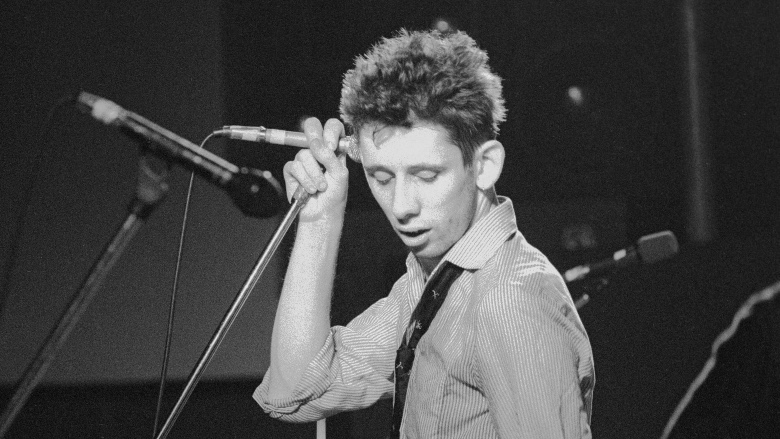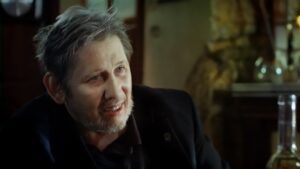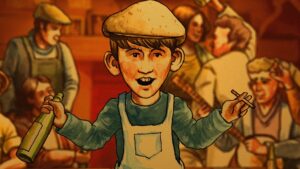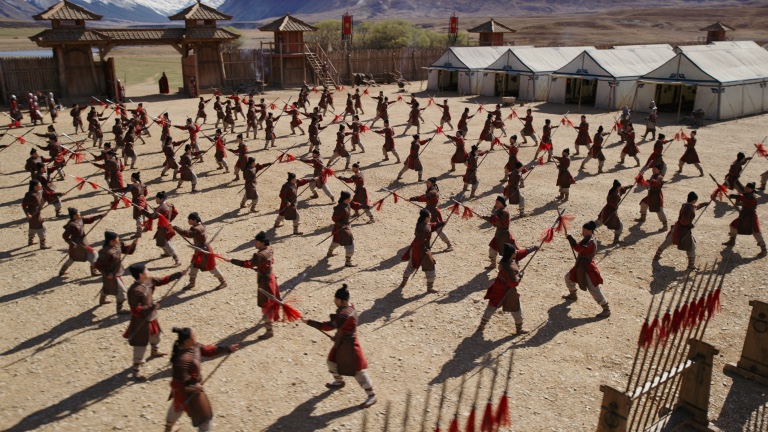
For forty years, filmmaker Julien Temple has been at the forefront of blending music with cinema, having made the first movie about punk pioneers, the Sex Pistols, with The Great Rock ‘n’ Roll Swindle in 1980, followed twenty years later with 2000’s The Filth and the Fury. Temple’s early ‘80s concert films, The Secret Policeman’s Other Ball and The Secret Policeman’s Private Parts, documented the annual comedy and music charity event with performances by Jeff Beck, Pete Townsend and Phil Collins before directing a string of ‘80s music videos for the likes of David Bowie, Culture Club and more.
Throughout his career, Temple has always returned to the world of documentary, notably with 2007’s Joe Strummer: The Future is Unwritten, about the late Clash frontman, and Keith Richards: The Origin of the Species. When it came to making a movie about Shane MacGowan, the enigmatic frontman for the Irish band The Pogues, who mixed punk with traditional Irish music, there were few more suitable than Temple to take on that task.
That brings us to Crock of Gold: A Few Rounds with Shane MacGowan, a two-hour voyage through the life of the chronic alcoholic who has managed to survive through his own 40-year journey through music, but whose full story has never been told before. Crock of Gold begins with MacGowan’s early days in the farmland of Ireland, follows him through his troubled school days and into the early days of punk rock, in which MacGowan was a notable punter in the audience.
Below the Line got on Zoom with Mr. Temple a few weeks back to talk about his latest doc, some of his past work and more.
Below the Line: You must have known Shane for a long time, because both of you were obviously involved in London’s punk scene back when it was beginning.
Julien Temple: Actually, the first interview that was ever done with Shane was something I did, which is in the film. I don’t know if you see him with the blonde-peroxide. I shot that in ‘76, before anyone else had talked to him actually, so I did know him a bit then. When Sid Vicious left the punk crowd in London and joined the band, there was a vacancy waiting in the crowd. I think Shane, in a way, filled that place that Sid, who was the focal point of the crowd. Shane just had that real desire to be connected to this energy. You can see it in his face. There are other shots of him actually watching the Clash, mainly, but you feel that intensity of his connection to the punk idea and the punk energy. Yeah, I do go way back, and a lot of good things came out of that punk moment.
BTL: I’m sure you had no idea at the time that he was going to lead his own band, the Pogues, nor that they’d be so successful.
Temple: No idea, whatsoever. You wouldn’t even know he was Irish. His name was a giveaway, but other than that, his accent was full London street, just a London punk. You would never have guessed that the kind of richness of his Irish legacy would flow through this amazing canon of work that he’s produced.

BTL: Were you touching base with him over the course of the years while doing other music stuff?
Temple: No, no, not particularly. It was surprising when he asked me to do the film actually. He and his friend, Gerry O’Boyle, contacted me, but I wasn’t quite sure whether I did want to do it. Obviously, he comes with a warning on the tin, “This mission, should you choose to accept it, could be problematic,” but I’m glad I did. The guy is definitely a fascinating and multifaceted personality. I tried to show the different sides to him that I think makes the whole. I certainly didn’t want to canonize him or demonize him. I just wanted people to have a 3D portrayal of his different aspects, that they can make their own mind up who this guy actually is, rather than trying to put him back in that box as a certain thing, I didn’t want to do that.
BTL: You can tell from the movie that he’s not the easiest subject. If he gets asked a question he doesn’t want to answer, he lets you know, and you kept all of that stuff in the movie. How much time did you spend with him yourself and who decided who he was going to sit down, such as Johnny Depp and Bobby Gillespie from Primal Scream?
Temple: Shane doesn’t want to do interviews. First thing he said to me was there were no interviews. He wasn’t doing any interviews, which sent us scurrying all around the world trying to find little bits of micro-cassette that some journalist hadn’t thrown away with Shane talking freely in a bar in Finland at four in the morning in 1985. Here, you find moments of both genius but also unfiltered, intimate, unguarded, the real Shane, which aggressive as he is in front of a camera, he’s not going to give you that same access, I don’t think. The fact that he’s difficult, I think did determine how the film came out, and made it a better film, because he painted us into so many corners, we had to bust out somehow and find different ways of dealing with telling his story.
BTL: As far as those interviews conducted in a bar, how did you deal with the background noise and the consistency of how his narration sounded? Did you just have a really good sound mixer to figure that out?
Temple: Well, we said f*ck it. As long as you can just about hear what it is, it doesn’t really matter. It gives it more of an authentic, abrasive, real, almost secretive quality, like you’re getting something you’re not meant to get kind of thing. I like that. We do show that it’s coming off a micro-cassette with a big close-up of it. Given that we had very little to work with in terms of Shane’s presence, one of the things that made a big difference was that he was staring me in the face, but I suddenly realized what you normally cut out of an interview is when the other guy is talking and your subject is not saying anything. You throw that stuff away. You keep the stuff when he’s talking, but I was looking at Shane when Johnny Depp was talking. And realizing, actually the emotions playing across his face don’t seem necessary only to be linked to what John is saying. There’s incredible tragic moments and humorous moments. He has a very expressive face, and I suddenly realized I won’t throw that stuff away. On the contrary, I’ll make it the centerpiece of the movie, and I’ll try and edit it, so that he’s listening to these bits of himself talking through different times and reacting to his own story, sometimes being told in two different ways, that he’s a witness to his own story, and he’s emotionally connecting through it. Normally, you would throw that stuff away, but here, it suddenly became a new way of making the film.
BTL: That’s partially why I was curious whether he had decided, “I’m going to sit down with Johnny Depp, do you want to film it?,” or was that your idea to bring in other people to try and get Shane to open up?
Temple: I think we agreed that if he wasn’t going to do an interview, conversations with other people would be something he could accept more easily. So it was a matter of finding people that he was cool with talking to, and not everyone we went after said “yes.” Some very interesting people did. Johnny obviously is involved in producing the film, so that made a lot of sense, but Shane and his people around him – Gerry O’Boyle, who is another executive producer on the film– were suggesting people and we thought about it and went after the ones we thought would show a different aspect to Shane. Obviously, he’s a very different person with Bobby Gillespie than he is with Gary Adams, and he is with Johnny Depp. It’s nice that each interview shows a different version of Shane.

BTL: I was curious about the archival footage in the movie, so was a lot of that stuff that you had shot back in the day that you still had access to and could find to throw in there? How much of the footage was stuff you had shot back in the day?
Temple: During the punk time, a lot of it was stuff that I had shot, but it’s just the punk time, the material in the punk era. Obviously, we had access to some great earlier footage of Ireland in the Independence War, all the way through the Troubles and so on. We went through a lot of material to find stuff that related to the story. I love that kind of detective trail of hunting down the archive, and then letting the archive speak to you and say, “I want to be in this film.” You kind of respond to those kind of vibes coming off the archive.
BTL: I especially liked the early footage of the Pogues. I’ll admit that I’m not a Pogues fan, and it’s probably because I first started hearing them as they were getting more commercial and getting big vs. their grungier earlier days when they were kind of a mess on stage.
Temple: I would think that was a better time to see them, rather than later.
BTL: Where did all that live footage come from?
Temple: On the detective trail, we knew there was only one real concert film of the Pogues at the Town and Country Club in Kentish Town in London in ’87, I think, but the film only existed on VHS. The quality was terrible, and it was not very well edited. They weren’t filmed that much actually, so that was all we had really as a major piece of film on them. We always thought that somewhere the rushes of this must exist what they originally shot. Just before the film was finished, we finally got news that these rushes had been found in Dublin. We suddenly had access to eight cameras, different angles, different songs. We started re-cutting it to this new material, which was from the original negative, much better quality. It was a Godsend really, but that can happen on the trail of really hunting down archives. You get these horrible dead ends that lead nowhere, but you sometimes hit the gold mine, which that was.
BTL: When I spoke with the director of Ronnie’s, about Ronnie Scott and his club, he was saying that the BBC filmed a lot of shows though they famously re-used their tapes and recorded over them.
Temple: Or some guy nicked it. There’s all sorts of ways it turns up, it’s very funny sometimes. Someone should make a film about the archive trail actually, and the weird people you meet. When I first worked with the Stones, it’s a thing about their history [from] back in the ‘80s. They said, “Go and see Ian Stewart,” who is the original piano player, but they told him he wasn’t good looking enough that he can be in the band, but he kept playing with them. Anyway, they said, “Go and see Ian, he’s got all the archive” and he’s in some bungalow in Surrey, outside London. I turn up there, and he says, “It’s over there,” and there was this kind of rusting Bedford van, which is an old truck, rusting away with condensation in the windows. I looked, and it’s just jam-packed with film cans just sitting in the English freezing winter, in the snow, and that was the Rolling Stones archive in the ‘80s. So you find it in the weirdest places.
BTL: I guess Bill Wyman became the band’s archivist later.
Temple: I think he was always an archivist. He was always writing down what color Keith’s socks were.

BTL: I love the animation you used, which adds a lot to Shane’s stories. How did you go about finding the animator and style you wanted to use?
Temple: I’ve worked a lot with a with a great animator friend of mine called Johnny Halifax, so he coordinated it for me. What I was keen to do was to use different styles of animation for different time periods. You open the film with this kind of Disney style of animation, classic Disney for the baby Shane born on Christmas Day on the magical Ireland snow scape, but then you go through different styles. When he’s a kid on the farm, we use the style of the famous George Orwell animated version of Animal Farm in the 1950s when Shane was a child. Then in the 60s, there was a very famous kids’ comic book called The Beano, very famous in England, and there was a key figure in one of the story lines that ran in the comic called The Bash Street Kids, and one of the main characters in this was a guy called Plug, who had the ears of Shane, those completely sticking out and a very Shane-like image. We based the 60s animation around that Beano, then you had the more psychedelic R. Crumb animation when his girlfriend’s having the acid trip, but then Ralph Steadman did the nightmare the Blue Marries on tour, did the drawings for it. Finally, we have the Japanese anime style when the band breaks up in Tokyo in the ‘80s, so it seemed to fit that they were in Japan, and you do that final scene with band in context. So it was a lot of fun, and they’re a great team of people who did the animation. I love directing animation, it’s something I’ve always done. I did it in The Rock and Roll Swindle when the Sex Pistols say, “You can’t do that. We’re not a f*cking cartoon.” Now, of course, you have cartoon bands like Gorillaz – they’re nothing else but cartoon, so times change.
We now take a short break from our interview to share an exclusive clip from Crock of Gold, which shows off some of that Ralph Steadman animation that Mr. Temple mentioned above, which you can watch below:
BTL: I’m really fascinated by your career, because you started off making documentaries, and then you started making music videos and then narrative films, but you always keep coming back to documentaries. Is that just because you were there for a lot of stuff and you have the easiest way into the material?
Temple: They’re slightly autobiographical only in the sense that I lived through this time, and I passionately connected with the music. In a way, they all have an element of me trying to work out what connection I have with the time I’ve lived through, which is certainly part of them. I do love the freedom that I have in them to experiment and to take risks that in a narrative film, they often don’t allow you that freedom. Certainly, the bigger the budget, the less freedom you have. So I do like working in these small budgets where I feel I can push the envelope a bit each time. I’m hoping to do some more drama-oriented work. I’ve got projects, that I hope I can bring some of this stuff I’ve discovered in this way of making documentaries that see how I can use that in a more fictional context.
I think one of the great things about people like Shane MacGowan is you’re dealing with facts, but you’re also dealing with fiction. There’s a great deal of self-invention and self-myth-creating in any interesting storyteller or artist like Shane, and like Keith Richards. A lot of people I’ve worked with who weave myths around themselves. What didn’t happen is often as important as what did. To me, documentaries are not just straight non-fiction. I just see them as cinema when you’re telling a written story, or a story that someone’s making up and telling you. It should all be a spectrum of cinema to me. It’s a visual medium, a medium that can make people laugh and cry. I don’t care whether it’s a Disney movie or if a kid shot it on Super 8 or high-def video. It doesn’t bother me what it is on, as long as the emotion of cinema comes through. I love smashing up all those different formats together, because different times saw the world in different ways. Super 8 was the way kids were captured in the ‘60s and VHS in the ‘80s. It tells you a lot about the time, the actual texture of the visual format.
BTL: You’ve obviously made a lot of movies, so are there people you always bring back to work with again?
Temple: I have a very small close-knit team that I make these documentaries with, a great cameraman called Steve Organ, and my editor Caroline Richards. There’s a producer I work with a lot called Stephen Malit, and they’re a very close, very creative team of people. For your readers, I think that’s the best way to make films. I’ve been on sets where I’ve been in charge of 100 people, 150, and you don’t have any connection with most of them. You’re just the apex at the top of this weird movie set pyramid. This way, you’re more like you’re in a rock and roll band together, and you’re doing it together. You all move the equipment and you get in the van, and whoever drives drives, and then you have a great drink at the end of the day. It’s a Jean Vigo way of making films, the spirit of independent cinema where you do it with your friends, and no one tells you how to do it. You’re constantly finding new ways of doing it together, which is really gratifying and exciting. The technology makes that more and more possible. It’s very easy to get great sound now in a way that it was impossible to do on your own before, for example.
BTL: Were you working on a Marvin Gaye movie at some point?
Temple: No, we shot that for five weeks, and then they announced they’ve run out of money, so unfortunately, it fell apart, which is strange for a film that late, because It’s a real waste of someone’s money. Yeah, it’s a great shame. It was about his period in Belgium when he was at his lowest ebb, before he came back with Sexual Healing. It’s a really interesting, intimate story about him, a real fish out of water in Ostend, Belgium, where he lived for nearly two years. Fascinating, but yeah, didn’t happen. I’ve got a project though about the brothers in the Kinks, a drama story, so I’m definitely working on that, so hopefully that will get made.
Crock of Gold: A Few Rounds with Shane MacGowan will be available via On Demand and Digital starting December 4. If you happen to be in Texas, Arizona or a few other areas across the country, you can catch Crock of Gold in special one-night theatrical screenings on Thursday, December 3, as listed here.
All photos courtesy of Magnolia Pictures.





